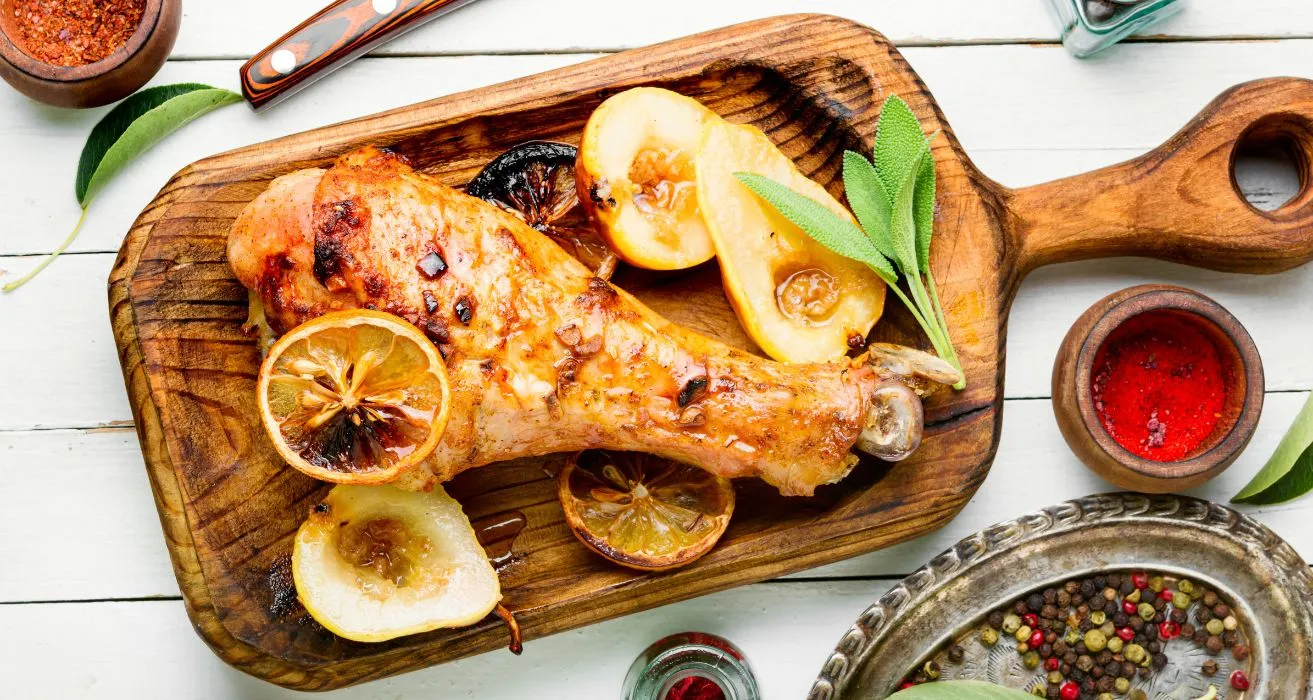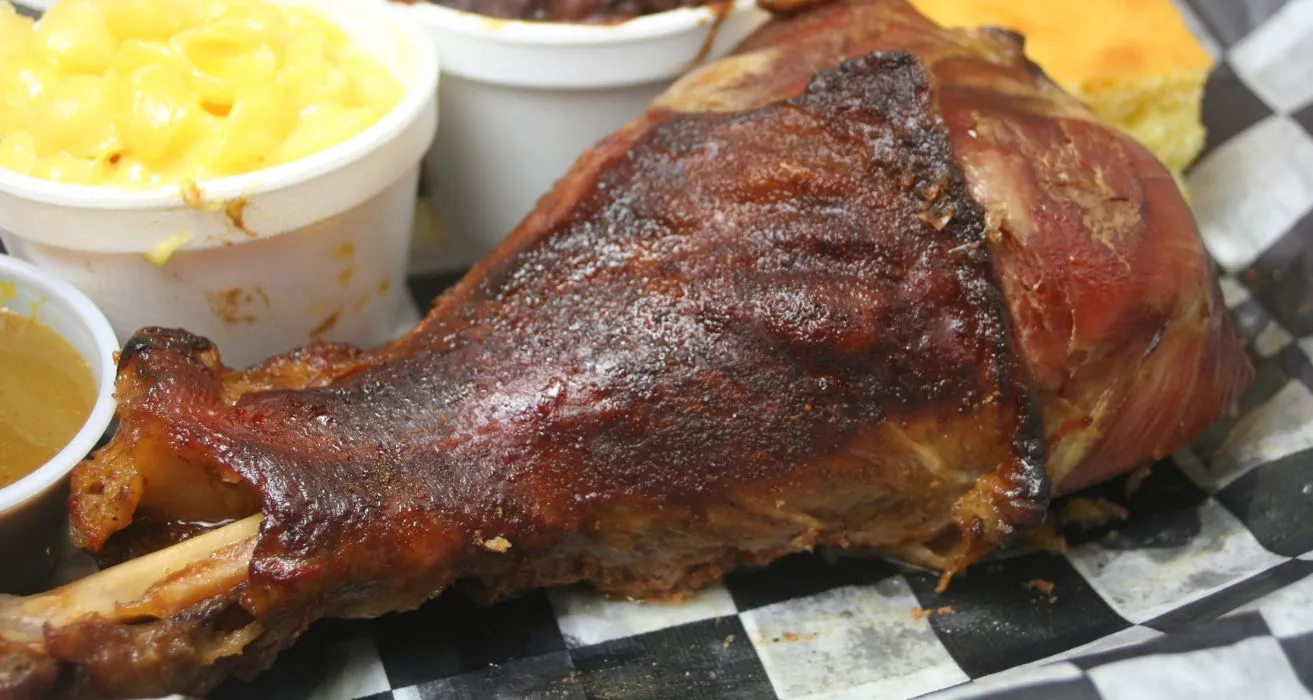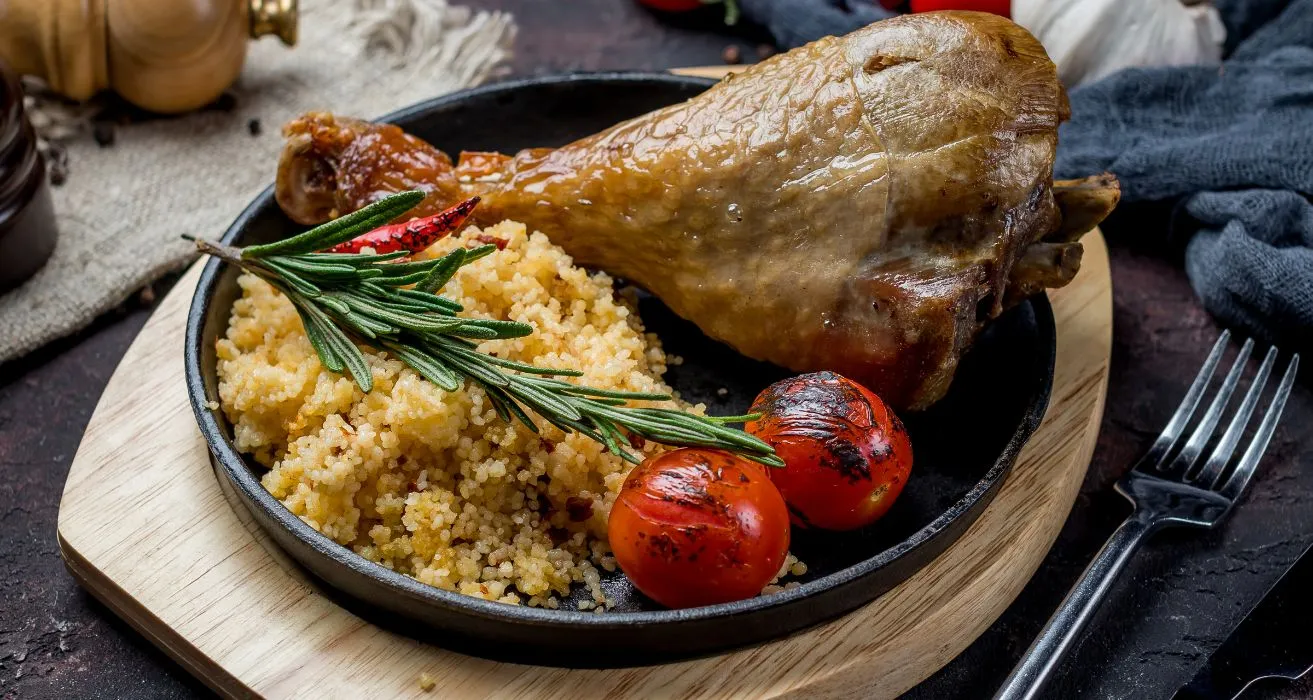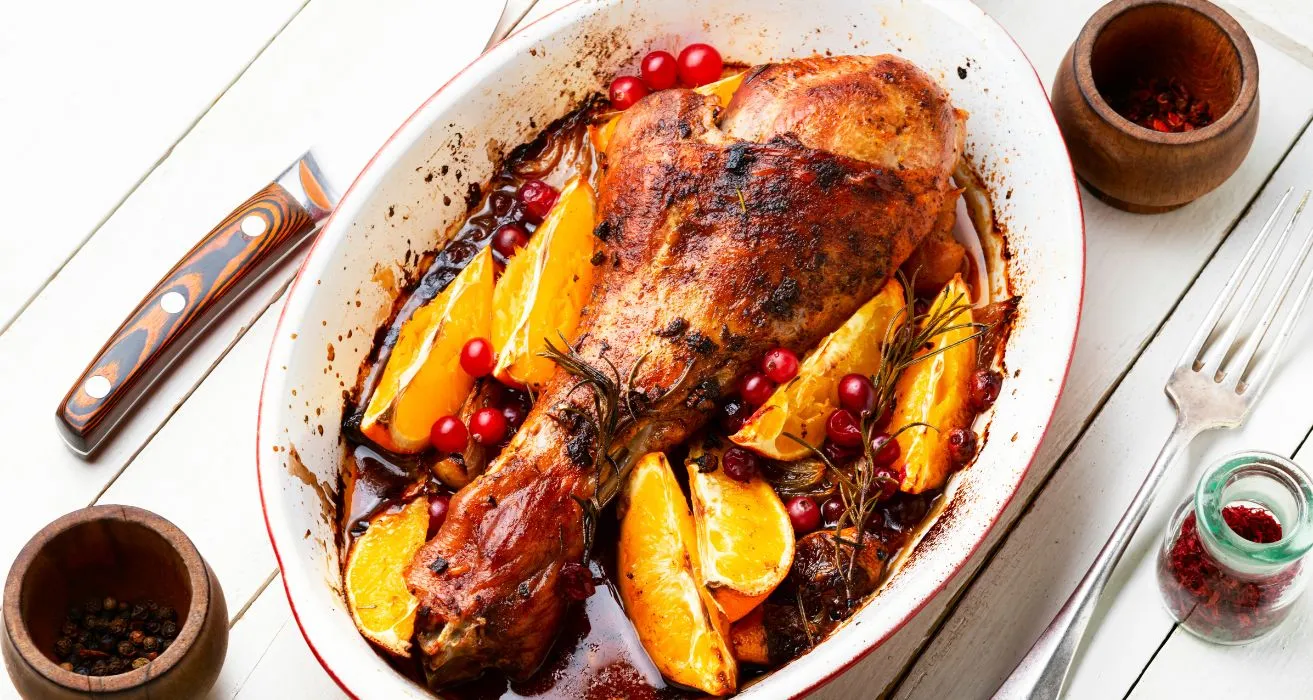In this comprehensive guide, we’ll dive deep into the world of turkey leg recipes. From selecting the best turkey legs to seasoning and cooking them to perfection, we’ve got you covered. Whether you’re a Thanksgiving enthusiast or just love the rich, dark meat of turkey legs, this article promises to transform your culinary skills. Along with expert cooking tips, we’ll include SEO-friendly content featuring LSI and NLP keywords to spice up your turkey leg recipes. Let’s get started with the first bite of this delicious journey!
Turkey legs, often overshadowed by the traditional whole turkey or turkey breast, hold a special place in the hearts of dark meat lovers. They’re not just for Renaissance fairs or theme parks; with the right recipe, turkey legs can be a mouthwatering main course for any occasion. Juicy, flavorful, and surprisingly simple to prepare, turkey legs offer a fantastic alternative to the more common poultry choices. In this section, we’ll explore why turkey legs deserve a spot on your dining table.
Why Turkey Legs Recipe are a Must-Try
Think of a turkey leg, and you might envision a massive, medieval feast where these meaty morsels are devoured with gusto. But there’s more to turkey legs than just their impressive size and nostalgic appeal. Turkey legs are rich in flavor, thanks to their dark meat composition. This type of meat not only packs a punch in terms of taste but is also juicier and more forgiving during the cooking process. Additionally, turkey legs are incredibly versatile. Whether roasted, smoked, or grilled, they absorb a variety of seasonings and marinades, making them a perfect canvas for culinary experimentation. So, why not give turkey legs recipe the spotlight they deserve in your next meal?
Selecting the Perfect Turkey Legs for Roasting
Choosing the right turkey legs is the first step to ensuring your dish turns out succulent and flavorful. This part of the bird, rich in dark meat, promises a depth of flavor white meat can hardly match. But, not all turkey legs are created equal. Let’s guide you through picking the best for your next culinary adventure.
Fresh vs. Frozen Turkey Legs
When it comes to turkey legs, the fresh vs. frozen debate is ever-present. Fresh turkey legs often boast a slightly superior texture and flavor, retaining more of their natural juices. They’re ready to marinate and cook without the need for thawing, saving you time in the kitchen. On the other hand, frozen turkey legs offer convenience and year-round availability. If opting for frozen, ensure they are thoroughly thawed in the refrigerator before cooking to achieve even cooking and optimal flavor. Remember, whether you choose fresh or frozen, look for turkey legs with skin on. The skin helps retain moisture during cooking, leading to a juicier result.
Understanding Turkey Leg Sizes and Portions
Turkey legs vary greatly in size, with some being hefty enough to feed two people. Generally, a single large turkey leg can weigh between 1 to 2 pounds. When planning your meal, consider the appetites of your guests. A good rule of thumb is one turkey leg per adult. However, if you’re serving a variety of dishes, you might get away with smaller portions. Always account for the bone when estimating serving sizes; despite their large appearance, the bone constitutes a significant part of the weight.
Selecting the ideal turkey legs is more than a matter of taste—it’s about knowing what works best for your recipe and your guests. Fresh or frozen, large or small, the perfect turkey leg is out there waiting to be transformed into a delicious masterpiece on your dining table. Stay tuned for our next section, where we’ll delve into the essential preparations for achieving the ultimate turkey leg feast.
Essential Prep Work for Mouthwatering Turkey Leg Recipe
Before the turkey legs hit the oven or grill, a bit of prep work is required to ensure they’re seasoned to perfection and ready to deliver the juiciest, most flavorful experience. This stage is where your culinary creativity can shine, turning simple ingredients into a feast for the senses.
Thawing and Cleaning
If you’re working with frozen turkey legs, the thawing process is crucial. The best method is to place them in the refrigerator for at least 24 hours before cooking. This slow thaw ensures the meat cooks evenly and retains its texture and flavor. Once thawed or if you’re using fresh turkey legs, give them a good rinse under cold water. Pat them dry with paper towels to remove any excess moisture. Dry skin is key to getting that deliciously crispy exterior once cooked.
To Brine or Not to Brine?
Brining is a debated topic among chefs and home cooks alike. For turkey legs, a simple brine can do wonders for enhancing moisture and flavor. Mix water, salt, and your choice of seasonings—sugar, garlic, herbs, and citrus zest work well—in a large container. Submerge the turkey legs for at least 4 hours, or overnight for deeper flavor penetration. If brining feels like too much of a hassle, a thorough seasoning before cooking can still yield fantastic results.
Seasoning Your Turkey Legs
The seasoning blend you choose will set the tone for your dish. Start with a base of salt and pepper, then add layers of flavor with garlic powder, smoked paprika, thyme, rosemary, or any of your favorite herbs and spices. Don’t be shy; turkey legs can handle bold flavors. Rub the seasoning mix all over the legs, ensuring every nook and cranny is covered. For an extra flavor boost, let them marinate in the seasoning for a few hours in the refrigerator.
Preparing turkey legs is a straightforward process that promises delicious rewards. With your turkey legs now thawed, cleaned, and seasoned, you’re ready to move on to the cooking stage. Whether you’re aiming for a crispy skin, a smoky aroma, or a tender and juicy interior, the right preparation sets the foundation for a delectable meal. Stay tuned, as we’re about to dive into the various methods of cooking turkey legs to perfection in the next section.
Mastering Turkey Leg Recipes: Oven Roasted, Grilled, and Smoked
With your turkey legs prepped and ready to go, it’s time to explore the cooking methods that will transform them into the star of your meal. Each method—oven roasting, grilling, and smoking—offers a unique flavor profile and texture, catering to every preference.
Oven Roasting for Crispy Skin
Oven roasting is perhaps the most straightforward method, ideal for achieving crispy skin and tender meat. Preheat your oven to 375°F (190°C). Place the seasoned turkey legs on a wire rack over a baking sheet or in a roasting pan. Roasting in a moderately hot oven ensures the skin crisps up without burning, while the meat cooks evenly and stays juicy. Roast for about 1 to 1.5 hours, depending on the size of the legs. The key to perfection? Use a meat thermometer to ensure the internal temperature reaches 165°F (74°C).
Grilling for a Smoky Flavor
For those who crave the smoky aroma and charred texture that only grilling can provide, turkey legs are a fantastic candidate. Preheat your grill to medium-high heat. Place the legs directly on the grill, turning every 10-15 minutes to ensure even cooking and prevent burning. Grilled turkey legs take about 45 minutes to 1 hour to cook through. Basting with a glaze during the last 15 minutes adds a deliciously sticky and caramelized finish.
Smoking for Deep, Rich Tastes
Smoking turkey legs recipe imparts a deep, rich flavor that’s hard to beat. Preheat your smoker to 225°F (107°C). Use your favorite wood chips—hickory, applewood, and cherry are all excellent choices for poultry. Place the turkey legs in the smoker and let the magic happen slowly. Smoking requires patience; expect the process to take anywhere from 4 to 6 hours. The low and slow approach guarantees meat that’s incredibly flavorful and fall-off-the-bone tender.
No matter which cooking method you choose, the result is bound to be delicious. Experimenting with different techniques and seasonings brings out the best in turkey legs, offering a versatile and satisfying meal. Remember, the key to great cooking is not just the method but the love and attention you put into it. Next up, we’ll delve into a selection of mouthwatering turkey leg recipes that are sure to impress your guests. Stay tuned!
Delectable Turkey Leg Recipes to Wow Your Guests
Turkey legs are not just for theme parks or Renaissance fairs; they can be the centerpiece of your dinner table with the right recipe. Let’s explore some delicious ways to prepare them that will have your guests asking for seconds.
Classic Roasted Turkey Legs Recipe
Roasting is a straightforward method that highlights the turkey’s natural flavors, complemented by a blend of herbs and spices.

Ingredients:
- 2 large turkey legs
- 2 tbsp olive oil
- 1 tsp salt
- 1/2 tsp black pepper
- 1 tsp garlic powder
- 1 tsp smoked paprika
- 1/2 tsp dried thyme
- 1/2 tsp dried rosemary
Directions:
- Preheat your oven to 375°F (190°C).
- Pat the turkey legs dry with paper towels. This helps achieve crispy skin.
- Rub olive oil over the turkey legs.
- Mix the salt, pepper, garlic powder, smoked paprika, thyme, and rosemary in a bowl. Sprinkle this seasoning mix evenly over the turkey legs.
- Place the turkey legs on a rack in a roasting pan to allow air circulation for even cooking.
- Roast in the preheated oven for about 90 minutes, or until the internal temperature reaches 165°F (74°C), and the skin is golden and crispy.
- Let rest for 10 minutes before serving to allow the juices to redistribute.
Spicy Smoked Turkey Legs Recipe
Smoking turkey legs infuse them with a rich, deep flavor and tenderness that’s hard to resist, especially with a spicy rub.

Ingredients:
- 2 large turkey legs
- 2 tbsp olive oil
- 1 tbsp brown sugar
- 2 tsp salt
- 1 tsp ground black pepper
- 1 tsp cayenne pepper (adjust to taste)
- 1 tsp garlic powder
- 1 tsp onion powder
- Wood chips for smoking (hickory or applewood recommended)
Directions:
- Preheat your smoker to 225°F (107°C).
- Mix the brown sugar, salt, black pepper, cayenne pepper, garlic powder, and onion powder in a bowl.
- Rub the turkey legs with olive oil, then coat them generously with the spice mix.
- Place the turkey legs in the smoker and smoke for about 4-6 hours, or until the internal temperature reaches 165°F (74°C).
- Rest the turkey legs for about 10 minutes before serving to ensure they retain their moisture.
Garlic and Herb Grilled Turkey Legs Recipe
Grilling gives turkey legs a wonderfully charred exterior and keeps the inside moist and flavorful.

Ingredients:
- 2 large turkey legs
- 2 tbsp olive oil
- 1 tbsp minced garlic
- 1 tsp salt
- 1/2 tsp black pepper
- 1 tsp rosemary, finely chopped
- 1 tsp thyme, finely chopped
Directions:
- Preheat your grill to medium-high heat.
- Mix olive oil, garlic, salt, pepper, rosemary, and thyme in a bowl.
- Rub the mixture all over the turkey legs, ensuring they are well-coated.
- Grill the turkey legs, turning occasionally, for about 45-60 minutes, or until the internal temperature reaches 165°F (74°C).
- Let the turkey legs rest for 10 minutes before serving.
Each of these recipes showcases a different method to cook turkey legs, offering a range of flavors and textures. Whether you prefer the classic roasted method, the deep flavor of smoking, or the charred goodness of grilling, there’s a turkey leg recipe here for everyone.
Serving Your Turkey Legs: Tips and Tricks
Once you’ve mastered the art of cooking turkey legs by roasting, grilling, or smoking, presenting them in a way that wows your guests is the next step. The right presentation can turn your meal from ordinary to extraordinary, making it a feast for the eyes as well as the palate.
Cutting and Presentation
After your turkey legs have rested and are ready to serve, you might consider slicing them for ease of eating or serving them whole for a more rustic and impressive presentation. If slicing, use a sharp knife to cut around the joints first. Then, slice the meat into thick pieces, allowing each slice to showcase the tender, juicy interior. Arrange the slices or whole legs on a platter, garnished with fresh herbs or edible flowers for a touch of elegance.
Side Dishes that Complement Turkey Legs
The side dishes you choose can elevate your turkey legs to a complete, harmonious meal. Consider the following pairings for a well-rounded dining experience:
- Roasted Vegetables: A medley of roasted root vegetables such as carrots, parsnips, and sweet potatoes adds color and a sweet, earthy flavor that complements the richness of the turkey.
- Mashed Potatoes: Creamy mashed potatoes make a classic pairing, serving as the perfect vehicle for savoring the turkey’s savory juices.
- Green Salad: A light, crisp green salad with a vinaigrette dressing can balance the heaviness of the meat, refreshing the palate between bites.
- Grain Salad: Quinoa or farro salads with a mix of fresh vegetables and a lemony dressing offer a nutritious and flavorful side that pairs well with turkey legs.
For an unforgettable meal, consider how each component of your dish – from the turkey legs to the sides and garnishes – comes together on the plate. Think about colors, textures, and flavors that complement each other, and don’t be afraid to get creative with your presentation. A little effort in presentation goes a long way in making your meal memorable.
By paying attention to both the taste and presentation of your turkey legs recipe, you’ll ensure your guests are impressed, satisfied, and eager for the next bite. Stay tuned for more culinary tips and tricks to elevate your cooking and dining experience.
FAQs
When diving into the delicious world of turkey leg recipes, a few questions often arise. Here, we’ll tackle some of the most common inquiries, ensuring you’re fully equipped to bring out the best in your poultry endeavors.
How do you keep turkey legs from drying out?
To prevent turkey legs from drying out, cooking them in pieces rather than whole can help. This method allows dark meat to cook properly without overcooking the lighter parts. For whole turkeys, choosing frozen ones and thawing them just once can also retain moisture better. Moreover, ditching the plastic pop-up timer for an instant-read thermometer ensures meat doesn’t overcook and dry out. Elevating the legs can help cook them evenly with the breast. Lastly, letting the turkey rest allows it to reabsorb juices, making it moist.
Should I wrap my turkey legs in foil?
Wrapping turkey legs in foil can be beneficial, especially to keep them moist during cooking. This method works well for both individual legs and when cooking the whole bird. The foil traps steam and heat, ensuring the legs cook evenly and remain tender. For a crispy skin, start cooking uncovered and then wrap in foil partway through, removing the foil towards the end to crisp up the skin.
How do you soften turkey legs?
To soften turkey legs, the cooking method matters significantly. Avoiding the microwave is crucial as it can dry out the meat and make the skin rubbery. Instead, using low and slow cooking methods, like oven baking with a pan of chicken broth underneath, can keep the meat moist and tender. Additionally, seasoning with a low sodium BBQ rub or poultry seasoning before cooking can enhance flavor without making the meat too salty.
Are turkey legs healthy?
Turkey legs are a healthy option, offering a high-protein choice for meals. A raw turkey leg has about 144 calories per 100 grams, and this number slightly increases to 170 calories when roasted. Removing the skin can reduce calorie intake. Turkey legs are an excellent protein source, with one leg providing about 28 grams of protein. However, they do contain fat, so balancing your overall fat intake is recommended. Cooking methods like roasting, braising, or smoking do not significantly increase the calorie content unless extra fat or high-calorie condiments are added.
How do you keep turkey legs from drying out?
To keep turkey legs juicy and prevent them from drying out, consider brining them before cooking. A brine, typically made from water, salt, and a combination of spices and sugar, helps to lock in moisture. If you’re short on time, make sure to baste the legs with their own juices or a marinade several times during cooking. Cooking at the right temperature is also crucial; low and slow is the mantra for moist turkey legs, especially when smoking.
Should I wrap my turkey legs in foil?
Wrapping turkey legs in foil can be beneficial, especially if you’re concerned about them drying out or if you want to ensure they cook evenly. When roasting or grilling, you might start the cooking process with the legs uncovered to allow the skin to become crispy, then wrap them in foil partway through to prevent the outside from burning before the inside is cooked. In a smoker, wrapping can help retain moisture and collect delicious juices that form during the cooking process.
Why are my baked turkey legs tough?
If your baked turkey legs turn out tough, it could be due to overcooking, cooking at too high a temperature, or not allowing them to rest after cooking. Dark meat, like that found in turkey legs, contains more connective tissue than white meat. Cooking slowly at a lower temperature can help break down these tissues, resulting in tender meat. Always use a meat thermometer to ensure you’re cooking the turkey legs to the correct internal temperature of 165°F (74°C), and let them rest covered in foil for about 10 minutes after cooking to allow the juices to redistribute.
What temperature should a turkey leg be cooked to?
For safety and optimal tenderness, turkey legs should be cooked to an internal temperature of 165°F (74°C). Use a meat thermometer inserted into the thickest part of the leg, avoiding the bone, to accurately gauge the temperature. Remember, the meat will continue to cook slightly after it’s removed from the heat source, so taking it out just as it reaches temperature will help prevent overcooking.
Armed with the answers to these frequently asked questions, you’re now ready to tackle turkey leg recipes with confidence. Remember, cooking is as much about intuition and experimentation as it is about following guidelines. Don’t be afraid to adjust techniques and seasonings to suit your taste. Happy cooking!
